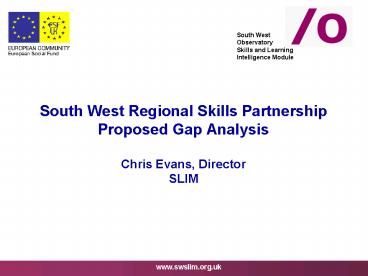South West - PowerPoint PPT Presentation
1 / 12
Title:
South West
Description:
Agreeing level 3 priorities. Identifying LCS, RDA, European and other budgets to support level 3 programmes ... A reliance on voluntarism to achieve policy objectives. ... – PowerPoint PPT presentation
Number of Views:11
Avg rating:3.0/5.0
Title: South West
1
South West Regional Skills PartnershipProposed
Gap AnalysisChris Evans, DirectorSLIM
2
Level 3 Review
- Part of the Healthy Labour Market Review
Thematic Review - Government has charged RSPs with
- Agreeing level 3 priorities
- Identifying LCS, RDA, European and other budgets
to support level 3 programmes to focus on
priority areas - Seeking funding contributions from employers
3
2005 Skills Strategy
We must substantially raise our ambition for
the number of people who gain Level 3 skills and
qualifications. By 2012, some two thirds of all
jobs (both new and existing) are expected to
require qualifications at Level 3 or higher. Some
of our most pronounced skills gaps relative to
France and Germany are in the crucial category of
technician, advanced craft, skilled trade and
associate professional skills requiring Level 3
qualifications. That is constraining growth in
productivity. For many people, qualifications at
Level 3 represent the way to a better standard of
living through gaining highly marketable
occupational skills. We will determine, in the
light of the review by Lord Leitch, what ambition
we should set for the future proportion of young
people and adults achieving Level 3
qualifications.
4
Current Level 3 needs
- NESS 2005 shows that sectors experiencing skills
shortages are retail hospitality construction
engineering and, social care. - There is a concentration, as a proportion of
employment and vacancies, of skill shortages
amongst technical, craft and operative/driver
staff in production industries, manufacturing and
transport.
5
Hard to fill and skills shortage vacancies
6
Policy Response
- Level 3 policy objectives are squeezed between a
focus on increasing the numbers of entrants to
Higher Education and a concentration of funds for
basic skills and level 2 qualifications. - A persistence of the higher status accorded to
academic routes to higher levels of education
over vocational options. - A reliance on voluntarism to achieve policy
objectives. - Reluctance on the part of employers to pay for
and of individuals in the workforce to take up
level 3 qualifications. - Extensive sectoral variation.
7
Next steps
- Review Level 3 data demand and supply
- Run regional analysis of the Leitch Review Models
- Analyse Policy Response
- Analyse wider literature
- Debate through the Learning Theme
- Interim working papers
- Final Report - December
8
Gap Analysis
- Where is the employer demand for skills and where
are the skills gaps? This will look at current
and future demand. - Where are the policies and funding of the key
agencies targeted in terms of being able to plan
for or respond to these needs? - Where do the gaps lie and what actions are needed
on the part of the RSP to fill them?
9
Skills Gaps
- International, national or inter-regional
comparisons, focusing on where the South West
compares poorly - Expected future changes, identifying key growth
areas and replacement needs these are areas
where supply will need to be focused to keep pace
with expected future needs. - Market signals, such as rates of pay and rates of
return, which reflect the balance between supply
and demand. - Employers perceptions, including recruitment
problems and internal skill gaps these indicate
those areas where there are the most significant
current skill deficiencies and shortages.
10
Regional priorities
- The analysis will look at priorities and planned
activities of the various strategic partners in
the region. Where are their efforts being
focused in relation to current and future skills
needs? We will therefore be reviewing the plans
and targets of the key partners - LSC
- RDA
- HEFCE
- Jobcentre Plus
- Business Link
11
Next Steps
- Confirm the parameters and the methodology of the
gap analysis - Commission work where necessary
- Progress Report
- Interim Report to be available for December.
- Final Report - presented to Board in January
2007 and to RSP Conference presentation of
findings.
12
Discussion
- Qualifications are a proxy for skills, but the
issue of generic skills are important. How
should we recognise this within the analysis? - We are proposing to cover the issue of skills
utilisation - how people deploy their skills
within the workplace - is this something that the
Board has views about? - Whilst we know a good deal about public funding
of skills, we know little about employer
contributions? How do we reconcile this issue in
the overall analysis? - Whilst the review will look at the data on
employer demand, how do we involve stakeholders,
particularly employers in a debate about regional
needs and priorities?































